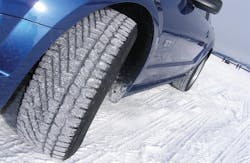The 2008/2009 winter tire season has been particularly robust, with tire dealers all over North America reporting higher-than-average sales thanks to cooperative weather, a new law that mandates the usage of winter tires in Quebec, and an ever-growing awareness of the effectiveness of dedicated winter tires.
This development was not entirely unexpected as a record number of winter tires (5.3 million) were shipped during 2008, a 23.2% increase over 2007 levels and the largest shipment increase of any domestic tire segment last year.
Continental Tire North America Inc. (CTNA) plans to capitalize on the winter tire boom in the United States and Canada with what it calls its “best winter tire to date,” the Continental ExtremeWinterContact.
Available for the 2009/2010 winter tire season, the tire will be manufactured in 52 sizes, ranging from 13 inches to 17 inches in diameter. It contains a variety of features, including elevated lateral grooves for improved dry handling; inclined longitudinal grooves for extra traction and braking in the snow; and a high-tech, flexible tread compound and high sipe density for ice braking, according to CTNA officials.
The ExtremeWinterContact’s size line-up also will include LT-metric offerings. (In addition, CTNA officials have announced that the company’s studdable General Altimax Arctic winter tire will receive LT sizes this year.)
Retail-focused
“Winter tires are an essential part of our strategy,” CTNA Executive Vice President Andreas Gerstenberger told dealers last month during a ride-and-drive for the ExtremeWinterContact held near Big Sky, Mont.
CTNA’s winter tire sales in the U.S. and Canada increased 46% in 2008. “We anticipate future growth because inventory levels are pretty low” due to flourishing demand, which has been amplified by Quebec’s recently implemented winter tire law, he said.
The law — which forces Quebec residents to run winter tires from December through March — siphoned supply from other Canadian provinces and even some northeastern U.S. states, which led to shortages in many prominent sizes.
CTNA’s marketing support of the ExtremeWinterContact will be “retail-focused,” according to Gerstenberger. CTNA’s Engage360 training program will include data on the new tire. Meanwhile, in-store point-of-purchase materials — including interactive tire stands that allow shoppers to physically feel the difference between all-season and winter tire compounds — will promote the company’s “45-degree rule.”
CTNA believes that winter tire performance is based on temperature, not the presence of snow or ice, and that dedicated tires should be placed on vehicles when the mercury drops to 45 degrees Fahrenheit. “Sixty percent to 70% of driving during winter conditions happens when you don’t have snow on the ground. We strongly believe that at the end of the day, the real switch to winter tires will be made at the retail counter.”
Closer to home
CTNA’s winter tire strategy “goes hand-in-hand with our production strategy,” said Gerstenberger.
The company currently imports all of its winter tires from Europe. That approach will change over the next couple of months when the company begins manufacturing winter tires at its plant in Mt. Vernon, Ill.
“Our winter tire sales have reached such a magnitude here that it makes sense to build tires at Mt. Vernon,” CTNA CEO Matthias Schonberg told MTD.
Producing winter tires in the U.S. will benefit both the company and its customers, he explained. “If you produce (tires) in the country with the same currency as the market, that helps. Secondly, you don’t have tires on the water,” so response time will improve.
Twenty-five percent of CTNA’s U.S./Canada winter tire sales volume will be produced at the Mt. Vernon facility, “with the long-term vision of getting up to 70%.”
The Mt. Vernon plant is undergoing a $200 million upgrade, Schonberg said. It has the capacity to build 28,000 passenger and 8,000 light truck tires per day, according to MTD research. ■



